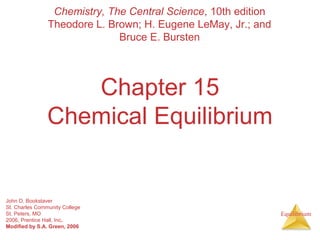1. The document discusses chemical equilibrium, including the concept that at equilibrium the forward and reverse reactions proceed at the same rate, and the amounts of reactants and products remain constant.
2. It introduces the equilibrium constant expression and explains how to write the expression for different chemical equations.
3. Le Châtelier's principle is discussed, that systems at equilibrium will shift in response to changes in conditions to counteract the effect of changes in temperature, pressure, or concentration.

![Equilibrium
Fast Initial Step
• Because Ratef = Rater ,
Solving for [NOBr2] gives us
Can also write as:](https://image.slidesharecdn.com/chap15lec-141124000352-conversion-gate02/85/Chemitry-Chemical-Equilibrium-2-320.jpg)















![Equilibrium Can Be Reached from Either
Equilibrium
Direction
Kc, the final ratio of [NO2]2 to [N2O4], reaches a
constant no matter what the initial concentrations
of NO2 and N2O4 are (with const T).](https://image.slidesharecdn.com/chap15lec-141124000352-conversion-gate02/85/Chemitry-Chemical-Equilibrium-18-320.jpg)









![Relationship between Kc and Kp
Substituting P=[A]RT into the expression for
Kp for each substance, the relationship
between Kc and Kp becomes
Equilibrium
Where:
Kp = Kc (RT)Dn
Dn = (moles of gaseous product) – (moles of gaseous reactant)
Hint: ‘products–reactants’ and ‘products over reactants’
is a common theme in chemistry.](https://image.slidesharecdn.com/chap15lec-141124000352-conversion-gate02/85/Chemitry-Chemical-Equilibrium-28-320.jpg)


![The Concentrations of Solids and
Liquids Are Essentially Constant
Therefore, the concentrations of solids
and liquids do not appear in the
equilibrium expression
Equilibrium
PbCl2 (s) Pb2+
(aq) + 2 Cl−
(aq)
Kc = [Pb2+] [Cl−]2](https://image.slidesharecdn.com/chap15lec-141124000352-conversion-gate02/85/Chemitry-Chemical-Equilibrium-31-320.jpg)





![Equilibrium
What Do We Know?
[H2], M [I2], M [HI], M
Initially 1.000 x 10-3 2.000 x 10-3 0
Change
At
Equilibrium
1.87 x 10-3
ICE method:](https://image.slidesharecdn.com/chap15lec-141124000352-conversion-gate02/85/Chemitry-Chemical-Equilibrium-37-320.jpg)
![Equilibrium
[HI] Increases by 1.87 x 10-3 M
[H2], M [I2], M [HI], M
Initially 1.000 x 10-3 2.000 x 10-3 0
Change +1.87 x 10-3
At
1.87 x 10-3
equilibrium](https://image.slidesharecdn.com/chap15lec-141124000352-conversion-gate02/85/Chemitry-Chemical-Equilibrium-38-320.jpg)
![Equilibrium
Stoichiometry tells us [H2] and [I2]
decrease by half as much
[H2], M [I2], M [HI], M
Initially 1.000 x 10-3 2.000 x 10-3 0
Change -9.35 x 10-4 -9.35 x 10-4 +1.87 x 10-3
At
1.87 x 10-3
equilibrium](https://image.slidesharecdn.com/chap15lec-141124000352-conversion-gate02/85/Chemitry-Chemical-Equilibrium-39-320.jpg)
![We can now calculate the equilibrium
concentrations of all three compounds…
[H2], M [I2], M [HI], M
Initially 1.000 x 10-3 2.000 x 10-3 0
Change -9.35 x 10-4 -9.35 x 10-4 +1.87 x 10-3
At
6.5 x 10-5 1.065 x 10-3 1.87 x 10-3
equilibrium
Equilibrium](https://image.slidesharecdn.com/chap15lec-141124000352-conversion-gate02/85/Chemitry-Chemical-Equilibrium-40-320.jpg)
![…and, therefore, the equilibrium constant
(6.5 x 10-5)(1.065 x 10-3)
Equilibrium
Kc = [HI]2
[H2] [I2]
= (1.87 x 10-3)2
= 51](https://image.slidesharecdn.com/chap15lec-141124000352-conversion-gate02/85/Chemitry-Chemical-Equilibrium-41-320.jpg)















